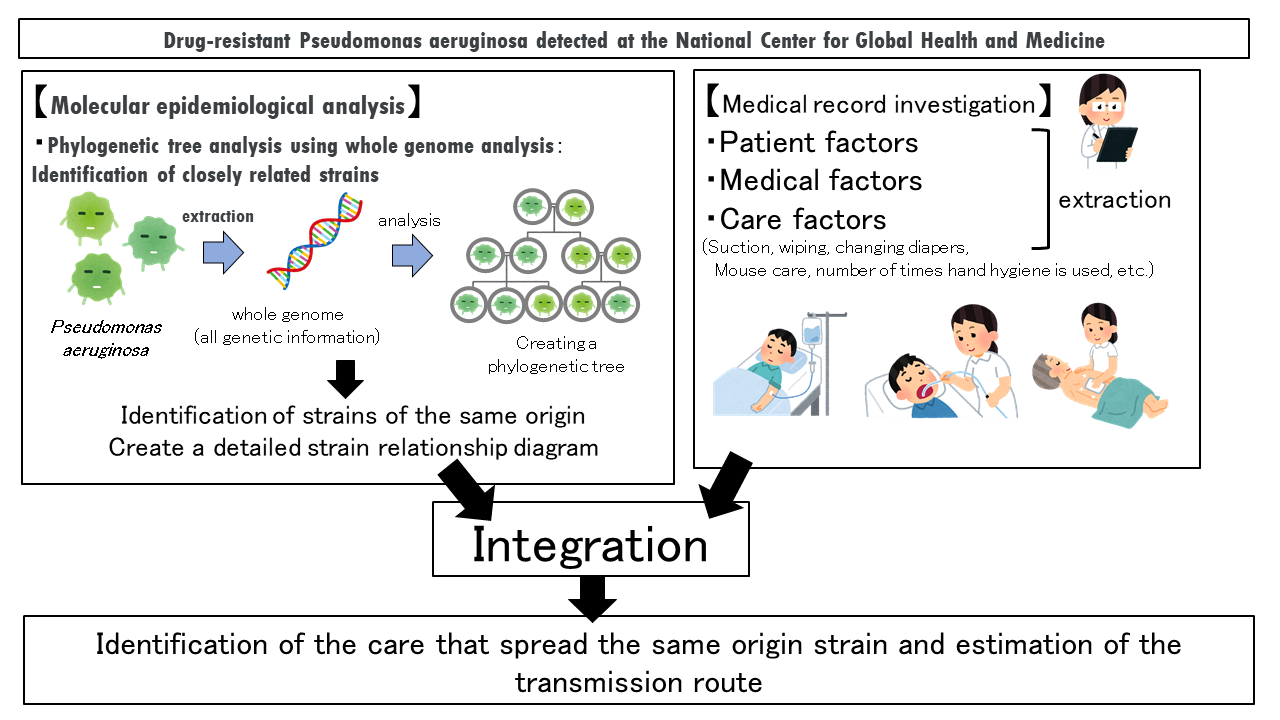Estimating the transmission route of drug-resistant Pseudomonas aeruginosa in nursing care
Abstract
Infections caused by drug-resistant Pseudomonas aeruginosa are difficult to treat and have a significant impact on patient prognosis and mortality.
Preventing the spread of drug-resistant Pseudomonas aeruginosa is important in hospitals.
The purpose of this study is to estimate how drug-resistant Pseudomonas aeruginosa is transmitted within a hospital, and to identify factors, such as nursing care which may cause the transmission.
The research method begins with molecular epidemiological analysis. In the molecular epidemiological analysis, we will examine the genes of drug-resistant Pseudomonas aeruginosa detected at the National Center for Global Health and Medicine. Even the same bacteria can have different strains. If there are drug-resistant Pseudomonas aeruginosa with the same gene and same origin detected, there might be transmission within the hospital. It is important to identify drug-resistant Pseudomonas aeruginosa that originate from the same origin. To this end, we will create a phylogenetic tree based on genetic data.
We then examine the medical records of patients who have been found to have drug-resistant Pseudomonas aeruginosa, probably from the same strain.
We will investigate patient factors (age, disease, etc.) and medical factors (use of medical devices and antibiotics, etc.) that have been identified in previous studies as factors in transmission.Further more , this study will also investigate the association between the nursing care provided to the patients (suctioning, cleaning, changing diapers, mouth care, number of times hand sanitizer was used, etc.)and the prevalence of drug-resistant Pseudomonas aeruginosa.
By integrating the results of the above molecular epidemiological analysis and clinical information obtained from review of medical records, this study will estimate the transmission route of drug-resistant Pseudomonas aeruginosa and identify the care that poses a risk.
The results of this study may prevent future transmission of drug-resistant Pseudomonas aeruginosa and contribute to infection control in hospitals.

Perspectives
・Contribute to prevent the transmission of drug-resistant Pseudomonas aeruginosa.
・Reduce infections with drug-resistant Pseudomonas aeruginosa.
・Contribute to improving infection control measures in hospitals.
Comments from principal researcher
Shiho Kubota, M.D.
National College of Nursing, Japan
Research curriculum department. Infection control nursing/National Center for Global Health and Medicine, Nursing department, Assistant Head Nurse
I am a Certified Nurse in Infection Control/Certified Nurse Specialist in Infection Control Nursing. I belonged to the hospital's in-hospital infection control room, where I took actions against drug-resistant bacteria. While working in the nosocomial infection control room, I experienced an outbreak of drug-resistant Pseudomonas aeruginosa and realized the importance of measures to prevent transmission.
By clarifying the transmission route of drug-resistant Pseudomonas aeruginosa and the care that causes it,I believe this contribute to preventing the transmission of drug-resistant Pseudomonas aeruginosa in the future.

Shared Researchers
Yutaro Akiyama, M.D.
National Center for Global Health and Medicine
Disease Control and Prevention Center
